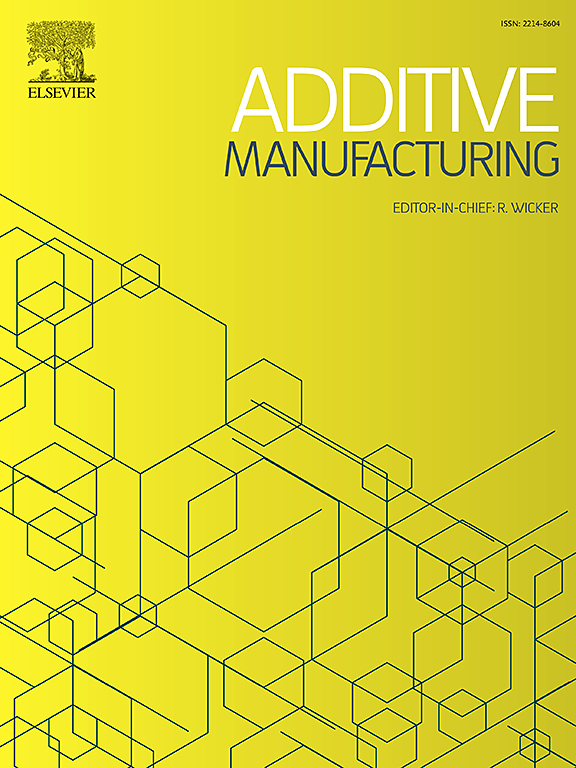先进还原光聚合的开放式双波长灰度数字光处理技术的发展
IF 10.3
1区 工程技术
Q1 ENGINEERING, MANUFACTURING
引用次数: 0
摘要
还原光聚合(VPP)是一种增材制造技术,通过将2D图像投影到光聚合物树脂层上来创建3D部件。这些图像通常使用带有数字微镜设备的数字光处理(DLP)系统传送。虽然传统的VPP依赖于单波长DLP系统,但最近的进展已经引入了多波长方法来选择性地触发不同的光化学反应,提高了多材料印刷和几何精度。为了进一步推进多波长VPP,开放架构的双波长DLP系统对于实现自适应曝光掩模的实时控制至关重要。在这项工作中,我们开发了一个正交的双波长灰度DLP系统,该系统具有定制光学器件和重新配置的基于现场可编程门阵列(FPGA)的控制电路。该系统集成了一个50/50分束光学架构,合并365 nm和460 nm光源,确保最小的畸变和精确对准。使用高分辨率CMOS相机和功率计来量化双波长曝光掩模的精度和对准。建立了通过FPGA编程实现投影对准和校准、灰度图像生成、补偿和比特流数据传输的工作流程,从而在构建平台上实现高分辨率、精确对准和空间精确的双波长灰度强度投影。通过光线追踪模拟、光学表征和实验样品打印验证了系统的性能。开发的体系结构促进了与机械化平台、计量工具和过程控制技术的集成,为可重复和精确的双波长VPP提供了坚实的基础。光学设计、FPGA编程和图像处理的精细方法推进了现有和新兴的多波长VPP技术,增强了它们在复杂材料系统和复杂应用中的能力。本文章由计算机程序翻译,如有差异,请以英文原文为准。
Development of open-architecture two-wavelength grayscale digital light processing for advanced vat photopolymerization
Vat photopolymerization (VPP) is an additive manufacturing technique that creates 3D parts by projecting 2D images onto layers of photopolymer resin. These images are often delivered using digital light processing (DLP) systems with digital micromirror devices. While conventional VPP relies on a single-wavelength DLP system, recent advancements have introduced multi-wavelength approaches to selectively trigger distinct photochemical reactions, enhancing multi-material printing and geometric precision. To further advance multi-wavelength VPP, open-architecture two-wavelength DLP systems are essential for enabling real-time control with adaptive exposure masks. In this work, we develop an orthogonal two-wavelength grayscale DLP system featuring custom optics and a reconfigured field-programmable gate array (FPGA)-based control circuit. The system integrates a 50/50 beam-splitting optical architecture that merges 365 nm and 460 nm light sources, ensuring minimal distortion and precise alignment. A high-resolution CMOS camera and power meter are used to quantify the accuracy and alignment of the two-wavelength exposure masks. A workflow for projection alignment and calibration, grayscale image generation, compensation, and bit-stream data transmission via FPGA programming is established, enabling high-resolution, precisely aligned, and spatially accurate two-wavelength grayscale intensity projections onto the build platform. The system’s performance is validated through ray-tracing simulations, optical characterizations, and experimental sample printing. The developed architecture facilitates integration with mechanized platforms, metrology tools, and process control technologies, providing a robust foundation for reproducible and precise two-wavelength VPP. The elaborate methodologies of optics design, FPGA programming, and image processing advance both existing and emerging multi-wavelength VPP technologies, enhancing their capability for complex material systems and sophisticated applications.
求助全文
通过发布文献求助,成功后即可免费获取论文全文。
去求助
来源期刊

Additive manufacturing
Materials Science-General Materials Science
CiteScore
19.80
自引率
12.70%
发文量
648
审稿时长
35 days
期刊介绍:
Additive Manufacturing stands as a peer-reviewed journal dedicated to delivering high-quality research papers and reviews in the field of additive manufacturing, serving both academia and industry leaders. The journal's objective is to recognize the innovative essence of additive manufacturing and its diverse applications, providing a comprehensive overview of current developments and future prospects.
The transformative potential of additive manufacturing technologies in product design and manufacturing is poised to disrupt traditional approaches. In response to this paradigm shift, a distinctive and comprehensive publication outlet was essential. Additive Manufacturing fulfills this need, offering a platform for engineers, materials scientists, and practitioners across academia and various industries to document and share innovations in these evolving technologies.
 求助内容:
求助内容: 应助结果提醒方式:
应助结果提醒方式:


